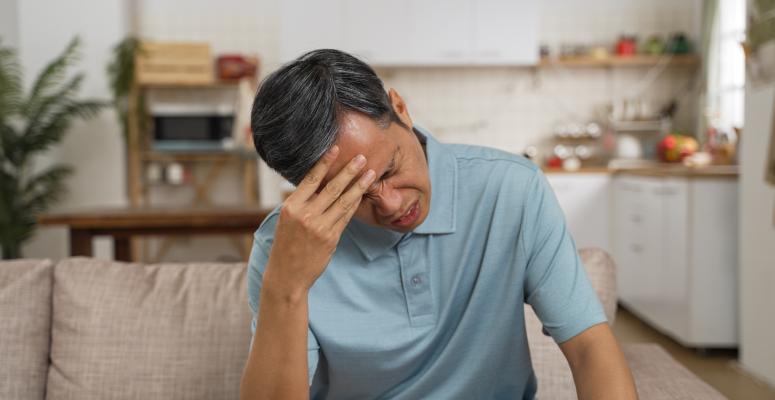
We’ve all experienced pain in our bodies. From injuries to tension headaches, nearly everyone knows what it’s like to feel a sting, ache or burn. But chronic pain is not the same as stubbing your toe or having body aches from the flu.
Chronic pain refers to pain that has been present in the body for at least 12 consecutive weeks. Research from 2016 shows that about 20.4% of adults in the United States struggle with chronic pain, with 8% having high-impact chronic pain. If left untreated, chronic pain can cause many long-term health issues.
Common forms of chronic pain that need treatment
Chronic pain can make itself known in a variety of ways. It can come in many different forms, such as:
- Headaches.
- Lower back pain.
- Arthritis.
- Cancer pain.
- Pain after surgery or trauma.
- Pain from nerve damage (neurogenic pain).
- Pain that isn’t linked to a medical issue (psychogenic pain).
What can happen if you leave chronic pain untreated
Many people shrug off pain because they believe it will heal with time. But that’s not always the case. Here are six possible long-term consequences that can stem from untreated chronic pain:
- Decreased concentration — Chronic pain can pull your concentration away from your daily activities and responsibilities because you’re only able to focus on how your body is feeling.
- Mental health disorders — People with chronic pain are 4 times more likely to have anxiety or depression than those who aren’t struggling with pain.
- Decreased mobility — Consistent and/or worsening chronic pain can be debilitating to the body over time. This can result in a decreased ability to move freely.
- Trouble sleeping — Similar to how chronic pain can pull you away from concentration, it can also interfere with your sleep patterns. The unrelenting aches can make it difficult for you to rest.
- Anorexia — Chronic pain may be linked to central sensitization, making your body’s nervous system sensitive to external factors, such as digesting food. This can increase the likelihood of developing an eating disorder like anorexia.
- Social isolation — People with chronic pain may struggle in social situations because their physical discomfort can be overwhelming. This can result in isolating themselves away from others.
Where is chronic pain found?
Chronic pain can affect nearly every part of your body. A few of the most common areas where chronic pain can live include the:
- Hip.
- Pelvis.
- Shoulder.
- Back.
- Foot/ankle.
While the treatment and physical therapy for each part can vary, the importance of treating chronic pain is equal for all of them. If left untreated, chronic pain can result in long-term health issues.
How to treat chronic pain with physical therapy to prevent long-term effects
Now that we understand the importance of treating chronic pain, where’s the best place to start your treatment?
There have been studies that support a wide range of treatments for chronic pain. From practicing tai chi to hypnosis, there are many different methods to alleviating pain. But one of the most effective methods is physical therapy.
There are many ways that physical therapy can be beneficial to someone struggling with chronic pain. Some of the benefits PT can offer for chronic pain are:
- Pain management — Probably the most important reason for physical therapy is that it can help you figure out effective techniques for managing your pain. This strategy focuses on teaching you how to avoid triggers that can cause your chronic pain to flare up.
- Mobility improvement — Physical therapy includes treatments that can help relieve tension in soft tissue as well as increase the mobility of your joints. Once such treatment option is manual therapy. This is a category of PT where a specialist uses their hands to move and apply pressure to areas where you're feeling chronic pain.
- Strengthened muscles — Physical therapy offers strengthening training that can help with weakness in your muscles and joints caused by chronic pain. Strengthening exercises not only reduce the risk of injury, but also help decrease your pain during daily tasks.
- Personalized treatment — As we noted earlier, not all chronic pain is the same. It can vary from person to person, both the pain location and severity. Physical therapy ensures that your treatment is tailored to your specific needs.
- Education — Your physical therapist can help you learn about the ins and out of your chronic pain, and what type of treatment will be the most effective for you. Learning about your condition will help you determine the best ways to handle it on a day-to-day basis.
Alliance PTP is ready to help you find top-notch PT for untreated chronic pain
At Alliance Physical Therapy Partners, we’re proudly bringing together physical therapy practices across the country to help people get the high-quality PT they need.
Want to see a physical therapist in person? We can put you in touch with an Alliance PTP partner that’s close to you and that can help you treat your chronic pain.
Not keen on in-person PT sessions or not close to an Alliance PTP partner? No worries. We also offer effective and affordable virtual physical therapy through our Agile Virtual Physical Therapy platform.
Come find help for your injury or chronic condition today!
Get Help at a Location Near You
